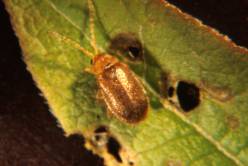203-Blueberry Leaf Beetle (Pyrrhalta vaccinii (Fall))
Fact Sheet No. 203, UMaine Extension No. 2369
Prepared by Judith A. Collins, Assistant Scientist, and H. Y. Forsythe, Jr., Professor of Entomology, in cooperation with David Yarborough, Extension Blueberry Specialist, The University of Maine, Orono, ME 04469. November 1995.
Description
The blueberry leaf beetle adults range in color from brownish-yellow to reddish-brown (Photo 1). The larvae are light greenish-gray and are about 1/8-inch long when fully grown. The yellowish pupae are found at least one inch deep in the soil.
Life Cycle
Blueberry leaf beetles pass the winter as adults hidden in the debris at the base of blueberry plants. They leave their winter quarters in late April to begin to feed on expanding leaf buds and to mate. The largest numbers of beetles occur on the foliage between May and early June. Eggs are deposited in crevices at the base of plant stems from late May to late July. When the eggs hatch, the larvae eat the foliage of blueberry plants. The larvae pupate in the soil, and a new generation of adults becomes common in late July. They feed on the foliage well into the fall before seeking overwintering sites.

Damage and Economic Importance
Adults and larvae of the blueberry leaf beetle damage blueberry plants by eating the lower surface of the leaf, leaving a lacy network of fine veins; this is called “skeletonizing.” The upper surface later turns brown. Infestations are usually confined to isolated areas and abandoned or poorly managed fields. However, when the beetles are very abundant for two or three successive seasons, they may kill blueberry plants over large areas.
Pest Management
For information regarding monitoring and control, contact the lowbush blueberry specialist, University of Maine Cooperative Extension, 1.800.897.0757 (toll-free in Maine) or 207.581.2923.
Information in this publication is provided purely for educational purposes. No responsibility is assumed for any problems associated with the use of products or services mentioned. No endorsement of products or companies is intended, nor is criticism of unnamed products or companies implied.
© 1995
Call 800.287.0274 (in Maine), or 207.581.3188, for information on publications and program offerings from University of Maine Cooperative Extension, or visit extension.umaine.edu.
The University of Maine is an EEO/AA employer, and does not discriminate on the grounds of race, color, religion, sex, sexual orientation, transgender status, gender expression, national origin, citizenship status, age, disability, genetic information or veteran’s status in employment, education, and all other programs and activities. The following person has been designated to handle inquiries regarding non-discrimination policies: Director of Equal Opportunity, 101 Boudreau Hall, University of Maine, Orono, ME 04469-5754, 207.581.1226, TTY 711 (Maine Relay System).
